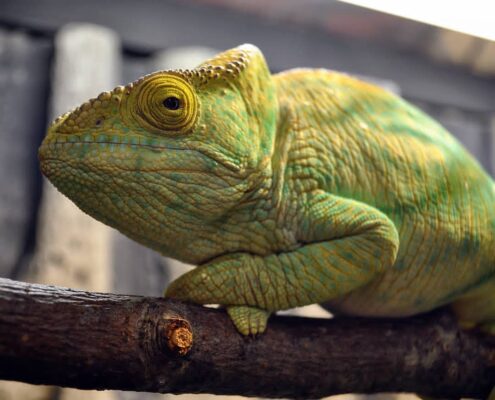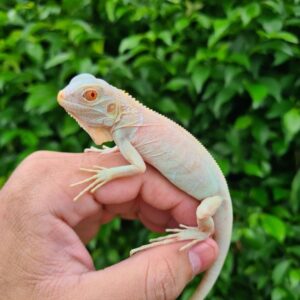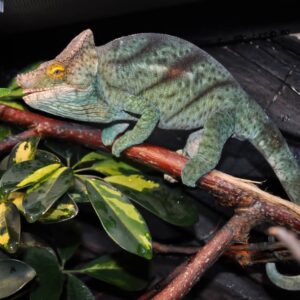Yellow Giant Parsons Chameleon For Sale
$2,400.00
Captive Bred
Yellow Giant Parson’s Chameleon are incredibly powerful creatures, capable of capturing their prey with their long tongues which can be up to two times their body length. They can also detect sounds and vibrations through their internal sensors, which allows them to sense when their prey is moving.
Description
Yellow Giant Parsons Chameleon
The Yellow Giant Parsons Chameleon, scientifically referred to as Calumma parsonii, is a remarkable species within the reptile world. This chameleon is easily distinguishable due to its vibrant yellow hue, a characteristic that not only makes it visually striking but also plays a role in its behavior and interactions within its natural habitat. The chameleon can grow significantly larger than many of its counterparts, with some individuals reaching lengths of up to 68 centimeters, making it one of the largest chameleons known to science.
One of the most notable physical features of the Yellow Giant Parsons Chameleon is its robust and powerful body structure. It possesses a prehensile tail, which it uses adeptly for grasping branches and maintaining balance as it navigates through the trees. The chameleon’s eyes are another fascinating aspect; they can move independently of each other, providing a wide field of vision and allowing it to scan its surroundings thoroughly for prey and potential threats.
Another distinguishing characteristic is the chameleon’s casque, a helmet-like structure on the top of its head, which varies in size and shape among individuals and can be an indicator of age and sex. This feature, combined with its bright coloration, makes the Yellow Giant Parsons Chameleon a highly sought-after species for observation by herpetologists and wildlife enthusiasts alike.
The significance of Calumma parsonii extends beyond its physical attributes. This species plays a vital role in the ecosystems it inhabits, primarily the rainforests of Madagascar. Its presence indicates a healthy environment, as chameleons are sensitive to habitat changes and pollution. Moreover, the study of this species contributes to a broader understanding of reptilian biodiversity and the evolutionary adaptations that enable chameleons to thrive in their specific niches.
As we delve deeper into the unique traits and behaviors of the Yellow Giant Parsons Chameleon, it becomes evident that this species is not just a marvel of nature but also a crucial component of the ecological tapestry of its native habitat.
The Yellow Giant Parsons Chameleon, a remarkable species native to Madagascar, thrives in a variety of distinct habitats across the island. Predominantly found in the eastern and northern regions of Madagascar, this chameleon prefers the lush, humid environments of the country’s tropical and subtropical rainforests. These forests provide the ideal conditions for the chameleon’s survival, offering ample foliage for camouflage, abundant insect prey, and a stable microclimate that supports its biological needs.
Madagascar’s rainforests, particularly around the Masoala Peninsula and the Andasibe-Mantadia National Park, are known hotspots for the Yellow Giant Parsons Chameleon. These regions provide the dense canopy cover and high humidity levels that are crucial for the chameleon’s well-being. The chameleon is often spotted in mid to low canopy levels, where it navigates the intricate network of branches and leaves, hunting for insects and occasionally small vertebrates.
The climatic conditions in these habitats feature consistent temperatures ranging from 20 to 25 degrees Celsius, coupled with high humidity levels, which are essential for the chameleon’s hydration and thermoregulation. The seasonal rainfall patterns in these regions also play a critical role in maintaining the microhabitats that the Yellow Giant Parsons Chameleon relies on. These conditions support a diverse and rich ecosystem, which is vital for the chameleon’s diet and overall habitat health.
However, the natural habitats that support the Yellow Giant Parsons Chameleon are under constant threat from deforestation, agricultural expansion, and urban development. Habitat conservation efforts are imperative to ensure the survival of this species. Conservation strategies, such as the establishment of protected areas and sustainable land-use practices, are crucial in preserving the forested regions of Madagascar. These measures not only protect the Yellow Giant Parsons Chameleon but also safeguard the broader biodiversity and ecological balance of the island.
Diet and Feeding Habits
The dietary preferences and feeding behaviors of the Yellow Giant Parsons Chameleon are as fascinating as they are diverse. In the wild, this remarkable reptile primarily subsists on a diet composed of various insects and small invertebrates. Its menu includes crickets, grasshoppers, beetles, and flies, which provide essential nutrients that contribute to the chameleon’s overall health and wellbeing. Occasionally, it supplements its diet with plant matter, such as leaves and fruits, helping to balance its nutritional intake.
One of the most intriguing aspects of the Yellow Giant Parsons Chameleon’s feeding habits is its hunting technique. This chameleon employs a unique strategy to capture its prey: it uses a long, sticky tongue that can extend rapidly to snatch insects from a distance. The tongue, covered in a sticky secretion, ensures that the prey adheres firmly upon contact, allowing the chameleon to reel it back into its mouth efficiently. This specialized feeding adaptation not only boosts its hunting success but also minimizes the energy expenditure required to catch fast-moving prey.
In addition to its remarkable tongue mechanism, the chameleon’s keen vision plays a crucial role in its hunting prowess. Its eyes can move independently, giving it a wide field of view and the ability to focus on multiple objects simultaneously. This visual acuity enables the chameleon to accurately judge distances and movements, essential for successful predation.
The diet of the Yellow Giant Parsons Chameleon is pivotal to its health. A varied and nutrient-rich diet supports its vibrant coloration, robust immune system, and overall vitality. In captivity, providing a diet that mimics its natural food sources is crucial to ensure its well-being. Supplemental vitamins and minerals may also be necessary to address any dietary deficiencies and to promote optimal health.
Understanding the dietary habits of the Yellow Giant Parsons Chameleon sheds light on the intricate balance of its ecosystem and the specialized adaptations that have evolved to support its survival. Through its unique feeding behaviors, this chameleon exemplifies the complex interplay between predator and prey in the natural world.
Reproduction and Lifespan
The Yellow Giant Parsons Chameleon exhibits a unique and intriguing reproductive cycle. Mating behaviors typically commence during the onset of the rainy season when the environmental conditions are most favorable for reproduction. The males engage in a series of dynamic displays, characterized by vivid color changes and physical posturing to attract potential mates. Once a female consents to mating, copulation usually lasts for several minutes to an hour.
After successful mating, the female embarks on a journey to locate an appropriate site for egg-laying. She meticulously digs a burrow in the soil where she deposits her clutch, which can range from 20 to 50 eggs. The eggs are then covered and left to incubate, a process that can take an extended period of up to 24 months depending on ambient temperature and humidity levels. This prolonged incubation is one of the longest among reptiles, reflecting the chameleon’s adaptation to its environment.
Upon hatching, the young chameleons emerge as miniature replicas of their parents, fully equipped to survive independently. These juveniles undergo various developmental stages as they progress to adulthood, marked by rapid growth and frequent molting. The transition from hatchling to mature adult is critical, with the first year being particularly vulnerable to predation and environmental stresses.
The lifespan of the Yellow Giant Parsons Chameleon varies significantly between wild and captive environments. In the wild, the average lifespan ranges from 5 to 7 years, constrained by natural factors such as predation, disease, and habitat conditions. Conversely, in captivity, where threats are minimized and care is optimized, these chameleons can live significantly longer, with some individuals reaching up to 9 or even 12 years of age. Proper husbandry, including diet, habitat maintenance, and medical care, plays a crucial role in extending their lifespan in captivity.
Behavior and Social Structure
The Yellow Giant Parsons Chameleon exhibits a fascinating array of behavioral patterns and a unique social structure. These chameleons are predominantly solitary creatures, often establishing and fiercely defending their own territories. Territorial disputes among males can be quite intense, involving elaborate displays of body language and color changes designed to intimidate rivals and assert dominance.
Interaction with other chameleons is generally limited to mating periods, during which males and females come into temporary contact. Outside of these times, encounters between individuals are typically avoided to minimize conflict. The chameleons’ daily activities primarily revolve around foraging for food, basking in the sun to regulate body temperature, and seeking shelter from predators.
Communication among Yellow Giant Parsons Chameleons is a sophisticated affair, heavily reliant on visual signals. These chameleons possess an extraordinary ability to change their skin color, which they utilize for various purposes. Color changes can signal different states such as aggression, submission, or readiness to mate. Additionally, these changes aid in camouflage, allowing the chameleons to blend seamlessly into their surroundings and evade predators.
Body language also plays a crucial role in their communication repertoire. Movements such as head-bobbing, swaying, and inflating the body can convey a range of messages to other chameleons. For instance, a slow, deliberate head-bob might indicate a non-threatening approach, while rapid movements could signal aggression or a defensive posture.
Overall, the behavior and social structure of the Yellow Giant Parsons Chameleon are intricately tied to their survival strategies. Their sophisticated communication methods not only help them navigate social interactions but also enhance their ability to thrive in their natural habitat. This complex interplay of territoriality, interaction, and communication underscores the remarkable adaptability and resilience of these captivating reptiles.
Threats and Conservation Status
The Yellow Giant Parsons Chameleon, an extraordinary species native to Madagascar, faces numerous threats that jeopardize its survival. One of the foremost challenges is habitat destruction. The rapid deforestation in Madagascar, driven by agricultural expansion, logging, and human settlement, has significantly reduced the natural habitat of this chameleon. As forests are cleared, the intricate ecosystems that these chameleons rely upon are dismantled, diminishing their chances of survival.
Climate change further exacerbates the situation. Altered weather patterns and rising temperatures impact the delicate balance of the chameleon’s ecosystem. Changes in precipitation and temperature can affect the availability of insects, which are the primary diet of the Yellow Giant Parsons Chameleon. This disruption in food supply can lead to malnutrition and decreased reproductive success, posing a serious threat to the species’ population stability.
Another critical concern is the illegal pet trade. Despite international regulations, the demand for exotic pets remains high, and the Yellow Giant Parsons Chameleon is not exempt. Capturing these chameleons for sale in the pet trade not only reduces their population in the wild but also subjects them to stressful and often lethal conditions during capture and transportation. The removal of individuals from their natural habitat disrupts breeding populations, further endangering their survival.
The conservation status of the Yellow Giant Parsons Chameleon reflects these pressing issues. Currently, the species is classified as Near Threatened on the International Union for Conservation of Nature (IUCN) Red List. This status underscores the need for immediate and sustained conservation efforts to prevent further decline. Various organizations are actively working to protect the chameleon’s habitat through reforestation projects, legal enforcement against illegal trade, and raising awareness about the species’ plight.
Collaborative efforts between local communities, governments, and international conservation groups are crucial. By promoting sustainable land use practices, enhancing legal frameworks, and fostering community engagement, there is hope to secure a future for the Yellow Giant Parsons Chameleon and the rich biodiversity of Madagascar.
Captive Care and Ethical Considerations
The Yellow Giant Parsons Chameleon, native to the lush, tropical forests of Madagascar, requires meticulous care when kept in captivity. Proper enclosure setup is crucial for replicating their natural habitat. A spacious, well-ventilated terrarium with ample vertical space is recommended. The enclosure should include multiple branches and foliage to simulate a forest canopy, providing climbing opportunities and hiding spots. Maintaining humidity levels between 60-80% and temperatures ranging from 75-85°F during the day, with a slight drop at night, is essential for their well-being.
Diet is another critical aspect of caring for Yellow Giant Parsons Chameleons. These insectivores thrive on a varied diet of gut-loaded insects such as crickets, locusts, and roaches. Supplementing their diet with calcium and vitamin D3 is necessary to prevent metabolic bone disease. Occasional feeding of fruits and leafy greens can provide additional nutrients and hydration. Fresh, clean water should be available at all times, and misting the enclosure regularly helps maintain the required humidity and provides drinking opportunities.
Health care for Yellow Giant Parsons Chameleons involves routine check-ups with a veterinarian experienced in reptile care. Monitoring for signs of illness, such as changes in appetite, lethargy, or respiratory issues, is crucial. Quarantine new additions to prevent the spread of diseases and parasites. Environmental enrichment, including the introduction of new climbing structures and varying the enclosure’s layout, can stimulate natural behaviors and enhance the chameleon’s quality of life.
Ethical considerations are paramount when keeping Yellow Giant Parsons Chameleons as pets. Supporting captive breeding programs helps reduce the pressure on wild populations and supports conservation efforts. Prospective owners must understand the long-term commitment involved and ensure they can provide the necessary care throughout the chameleon’s lifespan, which can exceed a decade. It is also important to acquire chameleons from reputable breeders who prioritize the health and welfare of their animals.
Interesting Facts and Myths
The Yellow Giant Parsons Chameleon, a marvel of the reptilian world, captivates with its unique characteristics and behaviors. One of the most fascinating facts about this chameleon is its size. As one of the largest chameleons in the world, it can grow up to 27 inches in length. This impressive size not only makes it a standout among chameleons but also a significant presence in its natural habitat in Madagascar.
Another intriguing aspect of the Yellow Giant Parsons Chameleon is its remarkable lifespan. Unlike many other chameleons, which may live for only a few years, this species can live up to 15 years in the wild, provided it faces minimal threats from predators and habitat destruction. This longevity adds another layer to its already fascinating biology.
Despite their formidable appearance, these chameleons are known for their gentle disposition. They are relatively docile compared to other chameleon species, making them a subject of interest for both researchers and reptile enthusiasts. This gentle nature, however, does not negate the importance of their conservation. Habitat loss and environmental changes pose significant threats to their population.
One common myth about the Yellow Giant Parsons Chameleon is that it changes color to match its surroundings. While it’s true that chameleons can change color, this species primarily does so for communication or temperature regulation rather than camouflage. The color changes are often subtle and serve as signals to other chameleons or to manage their body heat.
Additionally, there’s a misconception that these chameleons are solitary creatures. Although they are not typically found in large groups, they do exhibit social behaviors, especially during the mating season. Understanding these social interactions is crucial for their conservation and breeding programs.
The Yellow Giant Parsons Chameleon is a testament to the diversity and complexity of the natural world. Dispelling myths and spreading awareness about their true nature is vital for their preservation. As we continue to learn more about these extraordinary reptiles, it becomes increasingly clear how essential it is to protect their habitats and support conservation efforts.






